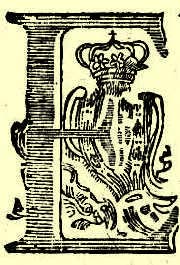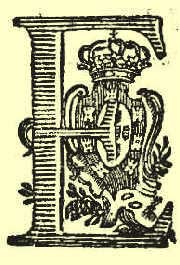
 |
 |
 |
 |
 |
 |
|
In 2000 the John Carter Brown Library (JCB) started the cataloguing of its copy of the Código Brasiliense, entering the descriptive data into RLIN. At the same time, similar copies of the same laws (and other documents), with different printing origins – mostly broadsides in loose leaves – were also recatalogued to bring the records up to the same standards. The reference sources available for the cataloguing of the Brazilian laws most commonly used at the JCB are Valle Cabral and Camargo & Moraes, although descriptions of some documents can also be found in other sources (see Bibliography). There are also in the Library some archival documents that tell the history of the acquisition of those laws. Our 3-volume set of the Código Brasiliense, all in folio,
was acquired in 1970 with the assistance of the Wormser Fund. It
is bound in calf (vols. 1 and 3), with an index at the beginning
of each volume. Spine title for vol. 1 reads: LEYS DO P. REG (leis
do Príncipe Regente, or
leis do período regencial, i.e., the Prince’s
laws or laws of the royal period, possibly) – TOM VIII. –
1805 (or 1806) – 1810 and includes items from 1808 to 1810.
Volume 2 is unbound, and the only one with a title page; When the JCB copy was acquired, it had an ex-libris with a name in it: F. da Sylveira Pinto Bz. (Francisco da Silveira Pinto Barboza?)
According to Susana Tavares Pedro, who holds a Master's Degree in Paleography and Diplomatics, the name in the ex-libris should be read as:
In the course of preparing cataloguing records at the JCB, aside from differences between editions, a controversy arose over whether some of the documents had been printed at the Impressão Régia in Rio de Janeiro or in Lisbon, since both cities had royal printing presses with the same name during the same period of time. This question was suggested by differences in typefaces, and in particular by the initial letter E in some documents. The speculation was based on a study by Stephen Ferguson, Assistant Bibliographer at the Library when the collection was acquired, who also published the article “The Código Brasiliense: Brazil’s first official legal code.” (Inter-American Review of Bibliography 24, n.2, April-June, 1974, p. 129-134.) Mr. Ferguson also clearly explained the differences in the initials E found in the documents from the Impressão Régia in Rio de Janeiro (initials of Document 9 and Document 14 are slightly different, for instance). Ana Maria Camargo, in her introduction to Bibliografia da Impressão Régia do Rio de Janeiro, stresses in the last paragraph that “it is necessary to take notice that the short imprint, with no place of publication in it – which was typical of the official documents printed at the Impressão Régia of Rio de Janeiro and Lisbon - makes it impossible to assure precision in determining a correct place of publication in this bibliography. The only clue to avoid confusion is very limited: the presence (not exclusive, unfortunately) of the carolingian S among the type faces used by the Impressão Régia in Lisbon in the first years of our [Brazilian] period. As other evidence is lacking, the best thing to do is to trace the history of the documents, before they got to archives and libraries.” Related correspondence can be found in the Library archives, including letters about other copies in the U.S., such as the ones at the Library of Congress, New York Public Library, Yale University, University of Illinois, Association of the Bar of the City of New York, Organization of American States/Pan American Union, and Harvard University. A search on Worldcat (July 2001) also showed other libraries in which the subject Brazilian laws published from 1808 can at first be found (yet to be verified), such as: SUNY at Stony Brook, Indiana University, Stanford University Libraries, University of California/UL, Oliveira Lima Library/DC, Florida State University, University of Florida, University of Miami, Tulane University, University of Minnesota, Washington University, Duke University Library, University of North Carolina, Columbia University, University of Pennsylvania, Vanderbilt University Library, University of Texas at Austin, University of Texas/Tarlton Law Library, and University of Wisconsin/Madison. Outside the U.S., other copies can also be found at the Biblioteca Nacional do Rio de Janeiro, Arquivo Nacional, Biblioteca José Mindlin, Biblioteca Pública Mário de Andrade in São Paulo, and Biblioteca Nacional in Lisbon, just to cite some institutions. As Thomas Adams, Librarian of the John Carter Brown Library in 1969, stated in a letter of July 1969 to Richard Wormser: “Indeed, this collection presents some fascinating problems that some day must be worked out”.
During the development of this web site we received the following information from Rizio Bruno Sant’Ana, rare book librarian and director of the Mário de Andrade Public Library in São Paulo. This library seems to have a copy that corresponds to our vol. 1, apparently bound in the middle of the 19th century with leather and marble paper. The spine reads “Impressão Régia, 1808–1809–1810, R. C. B”. The second endpaper has the ex-libris of Felix Pacheco, and a name written in pencil: Robert Carlton Brown, and the words “Brazilian-American”. The library also holds 9 more decrees of the same period bound in another volume with the same initials R. C. B., and one other decree from 1822 in loose-leaf. The Mário de Andrade Public Library also holds variant copies of the same documents. |




